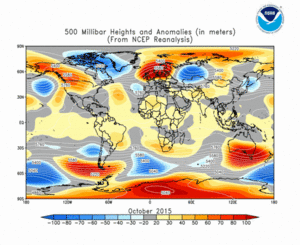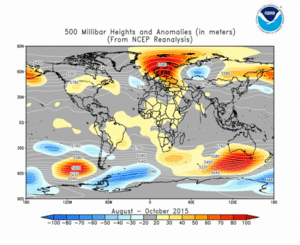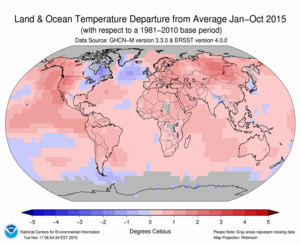Note: With this report and data release, the National Centers for Environmental Information is transitioning to improved versions of its global land (GHCN-M version 3.3.0) and ocean (ERSST version 4.0.0) datasets. Please note that anomalies and ranks reflect the historical record according to these updated versions. Historical months and years may differ from what was reported in previous reports. For more, please visit the associated FAQ and supplemental information.
Introduction
Temperature anomalies and percentiles are shown on the gridded maps below. The anomaly map on the left is a product of a merged land surface temperature (Global Historical Climatology Network, GHCN) and sea surface temperature (ERSST.v4) anomaly analysis as described in Huang et al. (2015). Temperature anomalies for land and ocean are analyzed separately and then merged to form the global analysis. For more information, please visit NCDC's Global Surface Temperature Anomalies page. The percentile map on the right provides additional information by placing the temperature anomaly observed for a specific place and time period into historical perspective, showing how the most current month, season or year compares with the past.
The most current data may be accessed via the Global Surface Temperature Anomalies page.
Temperatures
In the atmosphere, 500-millibar height anomalies correlate well with temperatures at the Earth's surface. The average position of the upper-level ridges of high pressure and troughs of low pressure—depicted by positive and negative 500-millibar height anomalies on the  October 2015 and
October 2015 and  August–October 2015 maps—is generally reflected by areas of positive and negative temperature anomalies at the surface, respectively.
August–October 2015 maps—is generally reflected by areas of positive and negative temperature anomalies at the surface, respectively.
October
The combined average temperature over global land and ocean surfaces for October 2015 was the highest for October in the 136-year period of record, at 0.98°C (1.76°F) above the 20th century average of 14.0°C (57.1°F). This marked the sixth consecutive month a monthly global temperature record has been broken and was also the greatest departure from average for any month in the 1630 months of recordkeeping, surpassing the previous record high departure set just last month by 0.13°F (0.07°C). The October temperature is currently increasing at an average rate of 0.06°C (0.11°F) per decade.
Separately, the October average temperature across global land surfaces was 1.33°C (2.39°F) above the 20th century average, the highest for October on record. This surpasses the previous record set in October 2011 by 0.17°C (0.31°F). This margin is larger than the uncertainty associated with the dataset. Large regions of Earth's land surfaces were much warmer than average, according to the Land & Ocean Temperature Percentiles map above. Record warmth was observed across the entire southern half of Australia, part of southern and southeastern Asia, much of central and southern Africa, most of Central America and northern South America, and parts of western North America. Regionally, Oceania and the African continent were both record warm. Argentina, part of northeastern Canada, scattered regions of western and central Russia, and central Japan were cooler or much cooler than average.
Select national information is highlighted below. (Please note that different countries report anomalies with respect to different base periods. The information provided here is based directly upon these data.):
- The average temperature across Australia during October was +2.89°C (+5.20°F) higher than its 1961–1990 average and the highest departure from average for any month in the country's 106-year period of record (1282 months), according to the Bureau of Meteorology. This surpasses the previous record of +2.75°C (4.95°F) set two years ago in September 2013. The October average maximum and minimum temperatures for the country were also each record high. The warmth was widespread, with all states and the Northern Territory observing daily average temperatures among their 10 warmest for October. New South Wales, Victoria, South Australia, and Western Australia were record warm, with the highest departure from average observed in South Australia, at +4.61°C (+8.30°F).
- It was also warmer than average across most of New Zealand. The national monthly temperature was 0.6°C (1.1°F) higher than the 1981–2010 average for October.
- Norway observed an October temperature that was 1.2°C (2.2°F) higher than its 1961–1990 average. Temperatures in Romsdal and Sør-Trøndelag were about 2–3°C (4–5°F) higher than their averages for October. The air flow patterns that brought the warmer-than-average temperatures are typical of El Niño conditions.
- The capital city of the Faroe Islands, Torshavn, observed its warmest October since 1920, at more than 2°C (4°F) higher than its 1961–1990 average.
With strong El Niño conditions in place, the October global sea surface temperature was 0.85°C (1.53°F) above the 20th century average of 15.9°C (60.6°F), the highest departure for October on record. This surpasses the previous record set in 2014 by 0.15°C (0.27°F). This margin is larger than the uncertainty associated with the dataset. The October temperature was also the highest departure from average for any month since recordkeeping began in 1880, surpassing the previous record set last month by 0.04°C (0.07°F). Sea surface temperatures during October 2015 were well above the 1981–2010 average across the central and eastern equatorial Pacific Ocean, according to analysis by the NOAA Climate Prediction Center (CPC). Record warm and much warmer-than-average temperatures are notable across the entire region, as shown by the October Temperature Percentiles map above. The CPC expects this El Niño to likely peak during the Northern Hemisphere winter 2015/16 and transition to ENSO-neutral conditions during late spring or early summer 2016. This forecast focuses on the ocean surface temperatures between 5°N and 5°S latitude and 170°W to 120°W longitude, called the Niño 3.4 region.
Other areas across the world's ocean surfaces also experienced record warmth or much warmer-than-average conditions for October, including the entire Indian Ocean where the Indian Ocean dipole has been positive during all of 2015, along with the central Atlantic Ocean and much of the Arctic Seas. A stretch of the Atlantic Ocean south of Greenland and a region southeast of South America were much cooler than average for the month.
| October | Anomaly | Rank (out of 136 years) | Records | ||||
|---|---|---|---|---|---|---|---|
| °C | °F | Year(s) | °C | °F | |||
| Global | |||||||
| Land | +1.33 ± 0.15 | +2.39 ± 0.27 | Warmest | 1st | 2015 | +1.33 | +2.39 |
| Coolest | 136th | 1912 | -0.92 | -1.66 | |||
| Ocean | +0.85 ± 0.03 | +1.53 ± 0.05 | Warmest | 1st | 2015 | +0.85 | +1.53 |
| Coolest | 136th | 1908, 1909 | -0.46 | -0.83 | |||
| Land and Ocean | +0.98 ± 0.07 | +1.76 ± 0.13 | Warmest | 1st | 2015 | +0.98 | +1.76 |
| Coolest | 136th | 1908, 1912 | -0.51 | -0.92 | |||
| Northern Hemisphere | |||||||
| Land | +1.27 ± 0.12 | +2.29 ± 0.22 | Warmest | 2nd | 2011 | +1.33 | +2.39 |
| Coolest | 135th | 1912 | -1.22 | -2.20 | |||
| Ocean | +1.05 ± 0.03 | +1.89 ± 0.05 | Warmest | 1st | 2015 | +1.05 | +1.89 |
| Coolest | 136th | 1908 | -0.53 | -0.95 | |||
| Land and Ocean | +1.13 ± 0.10 | +2.03 ± 0.18 | Warmest | 1st | 2015 | +1.13 | +2.03 |
| Coolest | 136th | 1912 | -0.73 | -1.31 | |||
| Southern Hemisphere | |||||||
| Land | +1.50 ± 0.22 | +2.70 ± 0.40 | Warmest | 1st | 2015 | +1.50 | +2.70 |
| Coolest | 136th | 1905 | -0.71 | -1.28 | |||
| Ocean | +0.71 ± 0.03 | +1.28 ± 0.05 | Warmest | 1st | 2015 | +0.71 | +1.28 |
| Coolest | 136th | 1909 | -0.42 | -0.76 | |||
| Land and Ocean | +0.83 ± 0.06 | +1.49 ± 0.11 | Warmest | 1st | 2015 | +0.83 | +1.49 |
| Coolest | 136th | 1910 | -0.45 | -0.81 | |||
| Arctic | |||||||
| Land and Ocean | +1.17 ± 0.28 | +2.11 ± 0.50 | Warmest | 11th | 1947 | +1.79 | +3.22 |
| Coolest | 126th | 1912 | -1.63 | -2.93 | |||
The most current data October be accessed via the Global Surface Temperature Anomalies page.
Year-to-date (January–October)
The first 10 months of 2015 comprised the warmest such period on record across the world's land and ocean surfaces, at 0.86°C (1.55°F) above the 20th century average, surpassing the previous record of 2014 by 0.12°C (0.22°F). This margin is larger than the uncertainty associated with the dataset. To date, eight months this year have been record warm for their respective months. January was the second warmest January on record and April third warmest.
The average global sea surface temperature of +0.71°C (+1.28°F) was the highest for January–October in the 136-year period of record, surpassing the previous record of 2014 by 0.08°C (0.14°F). This margin is larger than the uncertainty associated with the dataset. The average land surface temperature departure from average of +1.28°C (+2.30°F) was also the highest on record for October, surpassing the previous record of 2007 by 0.17°C (0.31°F).
Most of the world's land areas were much warmer than average, falling within the top 10 percent of their historical temperature range for the January–October period, as indicated by the Temperature Percentiles map above. These regions include South America, Central America, western North America, Africa, most of Eurasia, and large parts of Australia. Record warmth was observed across parts of each of these regions, particularly notable in western North America and much of South America.
The oceans were also much warmer than average across vast expanses, including most of the northern, eastern, and central equatorial Pacific Ocean, the entire Indian Ocean, much of the Atlantic Ocean, and the Arctic waters surrounding northern Europe. All four major ocean basins also had large regions of record warm sea surface temperatures during this 10-month period. In the North Atlantic, a large region south of Greenland remained much cooler than average for the period, with some record cold embedded in that area. Over land, only part of northeastern Canada and the far southern tip of South America were cooler than average during the January–October period.
| January–October | Anomaly | Rank (out of 136 years) | Records | ||||
|---|---|---|---|---|---|---|---|
| °C | °F | Year(s) | °C | °F | |||
| Global | |||||||
| Land | +1.28 ± 0.21 | +2.30 ± 0.38 | Warmest | 1st | 2015 | +1.28 | +2.30 |
| Coolest | 136th | 1893 | -0.65 | -1.17 | |||
| Ocean | +0.71 ± 0.02 | +1.28 ± 0.04 | Warmest | 1st | 2015 | +0.71 | +1.28 |
| Coolest | 136th | 1911 | -0.47 | -0.85 | |||
| Land and Ocean | +0.86 ± 0.10 | +1.55 ± 0.18 | Warmest | 1st | 2015 | +0.86 | +1.55 |
| Coolest | 136th | 1911 | -0.47 | -0.85 | |||
| Northern Hemisphere | |||||||
| Land | +1.38 ± 0.25 | +2.48 ± 0.45 | Warmest | 1st | 2015 | +1.38 | +2.48 |
| Coolest | 136th | 1884 | -0.72 | -1.30 | |||
| Ocean | +0.84 ± 0.02 | +1.51 ± 0.04 | Warmest | 1st | 2015 | +0.84 | +1.51 |
| Coolest | 136th | 1904, 1908, 1909 | -0.48 | -0.86 | |||
| Land and Ocean | +1.04 ± 0.14 | +1.87 ± 0.25 | Warmest | 1st | 2015 | +1.04 | +1.87 |
| Coolest | 136th | 1904 | -0.51 | -0.92 | |||
| Southern Hemisphere | |||||||
| Land | +1.02 ± 0.14 | +1.84 ± 0.25 | Warmest | 1st | 2015 | +1.02 | +1.84 |
| Coolest | 136th | 1891 | -0.64 | -1.15 | |||
| Ocean | +0.62 ± 0.03 | +1.12 ± 0.05 | Warmest | 1st | 2015 | +0.62 | +1.12 |
| Coolest | 136th | 1911 | -0.48 | -0.86 | |||
| Land and Ocean | +0.68 ± 0.07 | +1.22 ± 0.13 | Warmest | 1st | 2015 | +0.68 | +1.22 |
| Coolest | 136th | 1911 | -0.49 | -0.88 | |||
| Arctic | |||||||
| Land and Ocean | +1.50 ± 0.21 | +2.70 ± 0.38 | Warmest | 2nd | 2011 | +1.53 | +2.75 |
| Coolest | 135th | 1888 | -1.08 | -1.94 | |||
The most current data October be accessed via the Global Surface Temperature Anomalies page.
Precipitation
October
The maps below represent precipitation percent of normal (left, using a base period of 1961–1990) and precipitation percentiles (right, using the period of record). As is typical, precipitation varied significantly around the world.
Select national information is highlighted below. (Please note that different countries report anomalies with respect to different base periods. The information provided here is based directly upon these data):
- Denmark observed its driest October since 1972, with just 29 mm of rainfall, or about 30 percent of average for the month. The driest October occurred in 1922, when just 12 mm of precipitation fell.
- Latvia had its driest October on record, at 8.7 mm of rainfall for the month, or 13 percent of the average monthly rainfall. This breaks the previous record of 9.9 mm accumulation set in 1951.
References
- Peterson, T.C. and R.S. Vose, 1997: An Overview of the Global Historical Climatology Network Database. Bull. Amer. Meteorol. Soc., 78, 2837-2849.
- Huang, B., V.F. Banzon, E. Freeman, J. Lawrimore, W. Liu, T.C. Peterson, T.M. Smith, P.W. Thorne, S.D. Woodruff, and H-M. Zhang, 2015: Extended Reconstructed Sea Surface Temperature Version 4 (ERSST.v4). Part I: Upgrades and Intercomparisons. J. Climate, 28, 911-930.
 NOAA's National Centers for Environmental Information
NOAA's National Centers for Environmental Information










